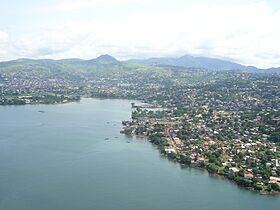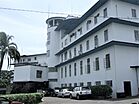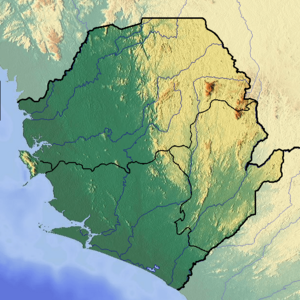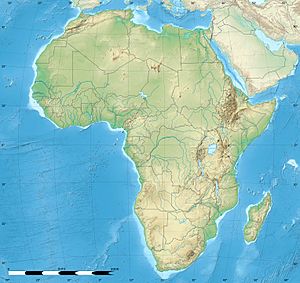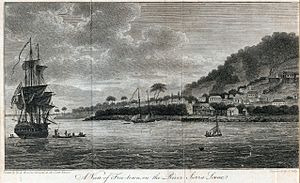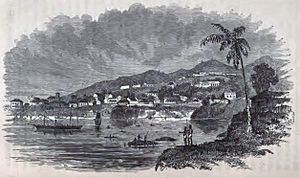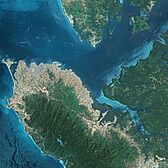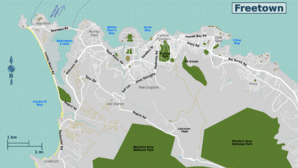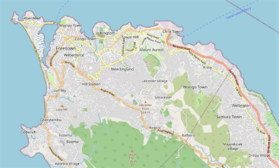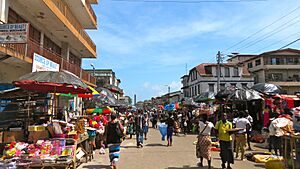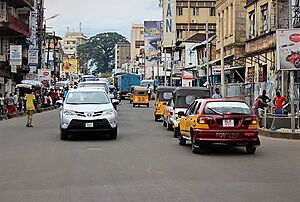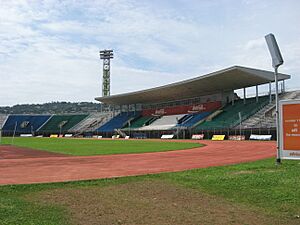Freetown facts for kids
Quick facts for kids
Freetown
|
|||
|---|---|---|---|
|
From top left: Aerial view, Freetown Court and Cotton Tree, Downtown Freetown, Sierra Leone National Stadium, Sierra Leone State House
|
|||
|
|||
| Country | |||
| Region | Western Area | ||
| District | Western Area Urban District | ||
| Founded | March 11, 1792 | ||
| Government | |||
| • Type | City council | ||
| Area | |||
| • Capital city and municipality | 81.48 km2 (31.46 sq mi) | ||
| Elevation | 26 m (85 ft) | ||
| Population
(2024 Census)
|
|||
| • Capital city and municipality | 1,347,559 | ||
| • Density | 16,538.5/km2 (42,834.6/sq mi) | ||
| • Metro | 1,500,234 | ||
| Time zone | Greenwich Mean Time | ||
Freetown is the capital city and largest city in Sierra Leone. It's a big port city located on the Atlantic Ocean. Freetown is the main hub for business, culture, education, and politics in Sierra Leone. It's also where the country's government is based. In 2024, about 1.3 million people lived there.
The city's economy mostly depends on its harbour. This harbour is part of the Sierra Leone River estuary and is one of the world's largest natural deep-water harbours.
Freetown is a very diverse city. People from all of Sierra Leone's ethnic groups live there. No single group makes up more than 27% of the population. The main language spoken in Freetown is Krio. This language comes from the Sierra Leone Creole people. It's the most common language used for talking to each other in the city.
Freetown was started on March 11, 1792. It was founded by 1,196 African Americans. They were guided by abolitionist Lieutenant John Clarkson. The city became a home for free and freed African American, Afro-Caribbean, and Liberated African slaves. Their descendants are known as the Creole people. Before Europeans arrived, the local Temne and Loko people lived in villages nearby.
The city of Freetown is run by a Freetown City Council. The people directly elect this council and its mayor. Elections happen every four years. The current mayor is Yvonne Aki Sawyerr. She was first elected in 2018 and then again in 2022. The Freetown city council also has its own municipal police force.
Contents
- History of Freetown
- Geography of Freetown
- Climate and Weather
- People and Languages
- Culture and Traditions
- Exploring Freetown: Tourism
- Famous Buildings and Places
- Places of Worship
- Freetown's Economy
- Education in Freetown
- Getting Around Freetown
- Sports in Freetown
- Sister Cities
- Images for kids
- See Also
History of Freetown
Early Settlements (1787–1789)
The area was first settled in 1787. About 400 formerly enslaved black people came from London, England. They were sent by a group called the Committee for the Relief of the Black Poor. These settlers were from different places, including America, the Caribbean, and Africa. They started a place called the 'Province of Freedom' and a settlement named Granville Town. They bought the land from local Koya Temne leaders, King Tom and Naimbana. The British thought they owned the land "for ever." But some historians believe the Koya leaders might have understood the agreement differently.
Soon, problems started. King Jimmy, who took over from King Tom, burned the settlement down in 1789. In 1791, Alexander Falconbridge gathered the remaining settlers. They rebuilt Granville Town near what is now Cline Town, Sierra Leone. This first group didn't officially found Freetown. The city was formally founded in 1792.
Founding the Freetown Colony (1792–1808)
In 1791, Thomas Peters, an African American, went to England. He spoke about the problems faced by black people in Nova Scotia. Many of these people were former slaves who had fought for the British in the American Revolution. They were promised land and help, but it was slow to arrive.
Peters met with the Sierra Leone Company. They wanted to start a new settlement in Sierra Leone. Lieutenant John Clarkson, RN, who was against slavery, went to Nova Scotia. He helped over 1,100 former American slaves sign up to move to Sierra Leone.
They sailed in 15 ships and arrived in St. George Bay in early 1792. Some settlers died on the journey. When they arrived, the men worked to clear the land. Lt. Clarkson told them to clear it until they reached a big cotton tree. After the work, everyone got off the ships and marched to the Cotton Tree. Their preachers, who were all African Americans, began singing.
In March 1792, a white preacher named Nathaniel Gilbert prayed under the Cotton Tree. Reverend David George preached the first Baptist service in Africa. The land was named 'Free Town' by the Sierra Leone Company. This was their first thanksgiving service.
John Clarkson became the first governor of Sierra Leone. Small huts were built before the rainy season. The city was planned like American cities, with straight streets. The largest street was Water Street. In August 1792, the older settlers from Granville Town joined the new Sierra Leone Colony.
In 1793, the settlers complained to the Sierra Leone Company. They were unhappy about how they were treated. They didn't like getting money that could only be spent at a company store. They also felt the governor, Mr. Dawes, was unfair. They said they hadn't received all the land Lt. Clarkson promised. They felt they were not treated as free people and asked for Lt. Clarkson to return.
Freetown was attacked by the French in 1794 but was rebuilt by the settlers. By 1798, Freetown had many houses. They looked like American houses, with stone bases and wooden tops. This style became common for the 'bod oses' of the Creole people.
In 1800, some Nova Scotians rebelled. About 550 Jamaican Maroons arrived and helped stop the rebellion. Some Nova Scotians were sent away. The Maroons were given land and later had their own area called Maroon Town.
Freetown as a British Colony (1808–1961)
Local Africans attacked the colony in 1801 but were pushed back. The British took control of Freetown in 1808. They made it a Crown Colony. This led to the creation of Sierra Leone.
From 1808 to 1874, Freetown was the capital of British West Africa. It was also a base for the Royal Navy's West Africa Squadron. This group worked to stop the slave trade. When they freed slaves from trading ships, they brought most of them to Freetown. So, the city's population grew with people from all over West Africa. The British also set up courts in Freetown to deal with slave trade cases.
These freed Africans built new areas around Freetown. They became the largest group of people who formed the Creole people of Freetown. The city grew quickly. Soldiers from the West Indies and Africa, who fought for Britain, also settled here. The descendants of these freed slaves and soldiers are called the Creoles. They play an important role in the city, even though they are a smaller part of Sierra Leone's total population.
During World War I, Freetown became a key base for British forces in the Atlantic. Warships came to the port for supplies. German merchant ships captured nearby were also sent there.
During World War II, Britain kept a naval base in Freetown. It was a stop for Allied ships in the South Atlantic. It was also where convoys of ships gathered before sailing to Britain. An RAF air base was at nearby Lungi airfield. British fighter planes shipped to Freetown were taken by train to Makeni to be put together and flown to Egypt.
Recent Events
Civil War (1990s to early 2000s)
Freetown saw heavy fighting during the Sierra Leone Civil War in the late 1990s. In 1998, troops from ECOWAS captured the city. They wanted to bring back President Ahmad Tejan Kabbah. Later, rebels from the Revolutionary United Front tried to attack the city but failed.
Mudslide Disaster (2017)
On August 14, 2017, after heavy rain, part of Mount Sugar Loaf collapsed. This caused a huge mudslide that tragically killed over 300 people in Regent town. People believe that cutting down too many trees (deforestation) made the landslide worse.
Fuel Tanker Explosion (2021)
On November 5, 2021, a fuel tanker truck crashed into another truck in Freetown. This caused a big explosion. At least 99 people died, and about 100 were injured.
Geography of Freetown
Freetown is next to the Atlantic Ocean and the Western Area Rural District. The city is divided into three main parts: East End, Central, and West End. The East End has the most people and is generally the poorest part of the city. The Queen Elizabeth II Quay, a major port, is in the East End.
Central Freetown includes Downtown Freetown and the main business area. Many important government buildings and foreign embassies are located here. Sierra Leone's House of Parliament and the State House (where the president works) are on Tower Hill in central Freetown. The National Stadium, where the national football team plays, is in the Brookfield neighborhood.
The West End of Freetown is generally wealthier. It has most of the city's fancy hotels, casinos, and Lumley Beach. The State Lodge, the president's official home, is in the Hill Station area of the West End.
Climate and Weather
Like the rest of Sierra Leone, Freetown has a tropical climate. It has a rainy season from May to November and a dry season for the rest of the year. Strong thunderstorms often mark the start and end of the rainy season. Freetown has a tropical monsoon climate because of how much rain it gets.
Freetown's high humidity is a bit less from December to February. This is due to the Harmattan, a wind that blows from the Sahara Desert. This wind brings the coolest temperatures of the year. Temperatures in Freetown usually range from 15°C to 38°C all year. The average yearly temperature is about 28°C.
| Climate data for Freetown, Sierra Leone (1961–1990, extremes 1947–1990) | |||||||||||||
|---|---|---|---|---|---|---|---|---|---|---|---|---|---|
| Month | Jan | Feb | Mar | Apr | May | Jun | Jul | Aug | Sep | Oct | Nov | Dec | Year |
| Record high °C (°F) | 36.0 (96.8) |
38.0 (100.4) |
38.0 (100.4) |
38.5 (101.3) |
35.0 (95.0) |
35.0 (95.0) |
33.0 (91.4) |
32.0 (89.6) |
31.0 (87.8) |
35.0 (95.0) |
36.5 (97.7) |
33.5 (92.3) |
38.5 (101.3) |
| Mean daily maximum °C (°F) | 29.9 (85.8) |
30.3 (86.5) |
30.9 (87.6) |
31.2 (88.2) |
30.9 (87.6) |
30.1 (86.2) |
28.7 (83.7) |
28.4 (83.1) |
29.0 (84.2) |
29.9 (85.8) |
30.1 (86.2) |
29.7 (85.5) |
29.9 (85.9) |
| Daily mean °C (°F) | 27.3 (81.1) |
27.6 (81.7) |
28.1 (82.6) |
28.5 (83.3) |
28.3 (82.9) |
27.4 (81.3) |
26.3 (79.3) |
25.9 (78.6) |
26.4 (79.5) |
27.1 (80.8) |
27.7 (81.9) |
27.5 (81.5) |
27.3 (81.2) |
| Mean daily minimum °C (°F) | 23.8 (74.8) |
24.0 (75.2) |
24.4 (75.9) |
24.8 (76.6) |
24.4 (75.9) |
23.6 (74.5) |
23.1 (73.6) |
23.0 (73.4) |
23.1 (73.6) |
23.4 (74.1) |
24.0 (75.2) |
24.1 (75.4) |
23.8 (74.9) |
| Record low °C (°F) | 15.0 (59.0) |
17.8 (64.0) |
19.4 (66.9) |
20.0 (68.0) |
20.6 (69.1) |
20.0 (68.0) |
19.4 (66.9) |
19.4 (66.9) |
20.0 (68.0) |
19.4 (66.9) |
20.0 (68.0) |
15.6 (60.1) |
15.0 (59.0) |
| Average rainfall mm (inches) | 8.0 (0.31) |
6.0 (0.24) |
28.0 (1.10) |
68.0 (2.68) |
214.0 (8.43) |
522.0 (20.55) |
1,190 (46.85) |
1,078 (42.44) |
800.0 (31.50) |
333.0 (13.11) |
148.0 (5.83) |
38.0 (1.50) |
4,433 (174.54) |
| Average rainy days | 0 | 0 | 1 | 4 | 15 | 22 | 27 | 27 | 24 | 21 | 9 | 2 | 152 |
| Average relative humidity (%) | 66 | 67 | 67 | 68 | 73 | 76 | 81 | 82 | 80 | 78 | 76 | 69 | 74 |
| Mean monthly sunshine hours | 226.3 | 215.6 | 232.5 | 207.0 | 189.1 | 153.0 | 102.3 | 86.8 | 126.0 | 186.0 | 198.0 | 161.2 | 2,083.8 |
| Source 1: NOAA, Deutscher Wetterdienst (extremes), | |||||||||||||
| Source 2: Worldwide Bioclimatic Classification System | |||||||||||||
People and Languages
Freetown has many Muslims and Christians. Muslims make up most of the population. Young people from both faiths often have modern views. Like the rest of Sierra Leone, Freetown is a city where people of different religions live together peacefully.
The Krio language is the most spoken language in Freetown. It's an English-based language from the Sierra Leone Creole people. Over 20% of the city's people speak Krio at home. Many more use it to communicate with others. English, the official language of Sierra Leone, is also widely spoken, especially by educated people. The Temne language is the second most spoken language in Freetown. The Temne people are also the largest ethnic group in Freetown and the Western Area.
| Historical population | ||
|---|---|---|
| Year | Pop. | ±% |
| 1974 | 276,247 | — |
| 1985 | 469,776 | +70.1% |
| 2004 | 772,873 | +64.5% |
| 2015 | 1,055,964 | +36.6% |
| source: | ||
Culture and Traditions
Freetown has the Sierra Leone National Museum and the Sierra Leone National Railway Museum. There are also many historical places linked to its founding. These places were important to the African Americans, Liberated Africans, and Afro-Caribbeans who settled here. The Cotton Tree marks the naming of Freetown in March 1792. In downtown Freetown, you can find the Connaught Hospital. It was the first hospital in West Africa to use Western medicine.
Freetown has a long history of cultural events. These events happen on special holidays or during certain seasons. One example is the Eastern Paddle Hunting Society's yearly masquerade. This involves a fancy costume made from materials like leather, sequins, and traditional cloths. The masquerade, called "Paddle," goes through the streets of the eastern and central parts of the city. Members of the society, traditional music bands, and crowds follow it. This event used to happen on the Muslim holiday of Eid al-Adha. However, critics said it shouldn't be on the same day as Eid, as Islam doesn't support secret societies and masquerades.
The "Tangays" Festival usually takes place in November. It celebrates many parts of Sierra Leonean culture. It happens at the National Stadium. Towards the end of the festival, there are usually music concerts. Local and international artists perform, especially modern artists from Nigeria and other African countries.
Freetown also has its own Christmas street parades. These are organized in different neighborhoods across the city. The celebrations last a month. Residents gather in the streets with lots of food and traditional music.
Exploring Freetown: Tourism
Tourism is a big part of Freetown. Even though the Civil War affected it, tourism has been getting better. The city has many things for tourists to see. There are long white sand beaches along the Freetown Peninsula. Lumley-Aberdeen beach stretches from Cape Sierra Leone to Lumley. Other popular beaches include River Number 2 Beach, Laka Beach, Tokeh Beach, Bureh Beach, and Mama Beach.
The Tacugama Chimpanzee Sanctuary is in the peninsula's rainforest. It's just a few miles from the city center. It's home to rare and endangered chimpanzees. Other popular places to visit are the Freetown Cotton Tree in Central Freetown. This is a very important national monument linked to the city's founding. You can also take a boat ride to Bunce Island. It has the ruins of a slave fortress used during the transatlantic slave trade. The Sierra Leone Museum has old artifacts and historical items. The National Railway Museum is also interesting. You can also take a trip along the city's coast with the Seacoach Express.
The Aberdeen-Lumley area is popular for nightlife. There are nightclubs, restaurants, and hotels near the beach.
Famous Buildings and Places
Near the city is the King's Yard Gate. It's made of stone and has a message: "any slave who passes through this gate is declared a free man." Freed Africans walked through this gate to gain their freedom. Down by the Naval Wharf are slave steps carved from stone. Before Freetown was built, Portuguese slave traders used these steps to take Africans to ships.
Freetown is home to Fourah Bay College. It's the oldest university in West Africa, started in 1827. This university was very important in Sierra Leone's history. Its first student, Samuel Ajayi Crowther, became the first African bishop in West Africa. The National Railway Museum has a special train car. It was built for Elizabeth II's visit in 1961. The Big Market on Wallace Johnson Street is a great place to see local artists' work.
The Freetown peninsula has many long white sand beaches. Lumley Beach, on the western side, is a popular spot for local parties and festivals.
Places of Worship
Freetown has many places of worship. Most are Christian churches, but there are also many Muslim mosques. Some Christian churches include the Roman Catholic Archdiocese of Freetown (Catholic Church), the United Methodist Church in Sierra Leone (World Methodist Council), the Baptist Convention of Sierra Leone (Baptist World Alliance), Assemblies of God, and St. George's Cathedral (Anglican), which opened in 1828.
Freetown's Economy
Freetown is the main economic and financial center of Sierra Leone. The country's state TV and radio station, the Sierra Leone Broadcasting Corporation, is based here. Other national broadcasters like AYV and Capital Radio are also in Freetown. Many of the country's biggest companies and most international companies have their main offices in Freetown, especially in Central Freetown.
The city's economy largely depends on its natural harbour. This is the largest natural harbour in Africa. The Queen Elizabeth II Quay can handle large ships and is used for Sierra Leone's main exports.
Industries in Freetown include making food and drinks, packing fish, processing rice, refining oil, cutting diamonds, and making cigarettes, paint, textiles, and beer.
The city is served by the Freetown International Airport. It's located in Lungi, across the river from Freetown.
Almost every neighborhood in Freetown has high streets with many different shops. Shop owners include both locals and foreigners. However, most locals prefer to shop in popular areas like Lumley Junction, Eastern Police Junction, PZ area, and Shell Junction.
Education in Freetown
Freetown, like the rest of Sierra Leone, has a school system. It includes six years of primary school (Classes 1 to 6) and six years of secondary school (Forms 1 to 6). Secondary schools are split into Junior secondary (Forms 1 to 3) and Senior secondary (Forms 4 to 6). This is called the 6-3-3-4 system: 6 years primary, 3 years junior secondary, 3 years senior secondary, and 4 years university.
Primary school students are usually 6 to 12 years old. Secondary school students are typically 13 to 18 years old. Primary education is free and required in public schools. Freetown is home to Fourah Bay College, one of the country's two main universities. It is the oldest university in West Africa, founded in 1827.
Getting Around Freetown
Air Travel
Freetown International Airport serves Freetown and the country. It's in Lungi, about 17 km northeast of Freetown, across the sea. It's the main airport for flights to and from Sierra Leone. The Sierra Leone Airports Authority runs the airport. There are frequent fast boats, buses, and ferry services to Freetown. Hastings Airport is a smaller airport. It can only handle small planes because its runway is short. It's about 14 km southeast of downtown Freetown.
Transfers to Freetown
Passengers can choose from hovercraft, ferry, road (5 hours), speedboat, water taxi, local banana boats, and helicopter to cross the river to Freetown. The ferry is the cheapest way. Sometimes, hovercraft and ferry services have been stopped due to too many passengers or safety concerns.
Sea Access
Sierra Leone has the largest natural harbour in Africa. Ships from all over the world dock at Freetown's Queen Elizabeth II Quay. Passenger, cargo, and private boats also use Government Wharf, which is closer to central Freetown. New investments have brought in modern cargo scanning equipment.
Land Access
Roads
Sierra Leone's roads are limited. The Sierra Leone Roads Authority (SLRA) manages the roads and highways. Main roads have been rebuilt to a good standard. Highway 1 enters the city from Waterloo, a town to the south.
Railways
The Sierra Leone Government Railway, which connected Freetown to the rest of the country, closed permanently in 1974. This was based on a recommendation from the International Bank for Reconstruction and Development. The iron rails were stolen in the years that followed.
Sports in Freetown
Like the rest of Sierra Leone, football is the most popular sport in Freetown. The Sierra Leone national football team, known as the Leone Stars, plays all their home games at Freetown's National Stadium. This is the largest stadium in Sierra Leone.
Eight of the fifteen clubs in the Sierra Leone National Premier League are from Freetown. This includes two of Sierra Leone's biggest football clubs, East End Lions and Mighty Blackpool. A match between these two teams is the biggest local football game in Sierra Leone. A well-known Sierra Leonean footballer is Kei Kamara, who plays for Los Angeles FC in Major League Soccer.
Sister Cities
Freetown is officially connected with five other cities around the world:
| City | Province / Region / State | Country | Year | Ref |
|---|---|---|---|---|
| South Carolina | 2019 | |||
| Hefei | Anhui | |||
| Missouri | ||||
| England | 1979 | |||
| New Haven | Connecticut |
Images for kids
See Also
 In Spanish: Freetown para niños
In Spanish: Freetown para niños


